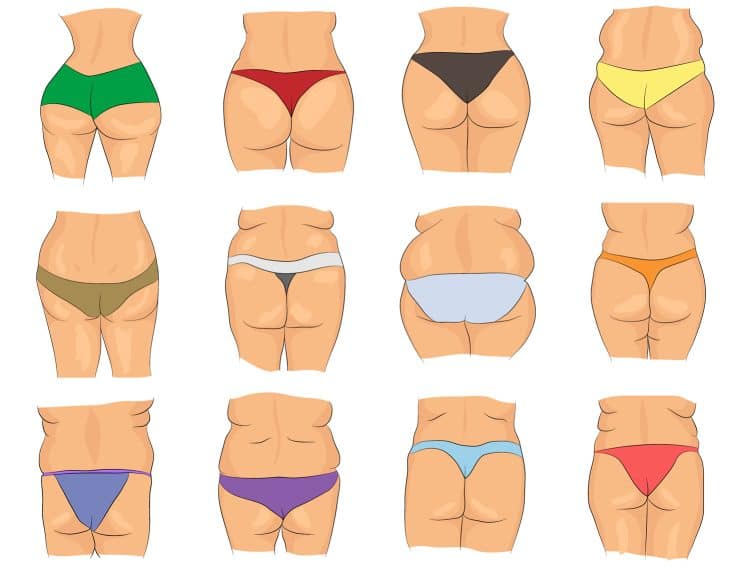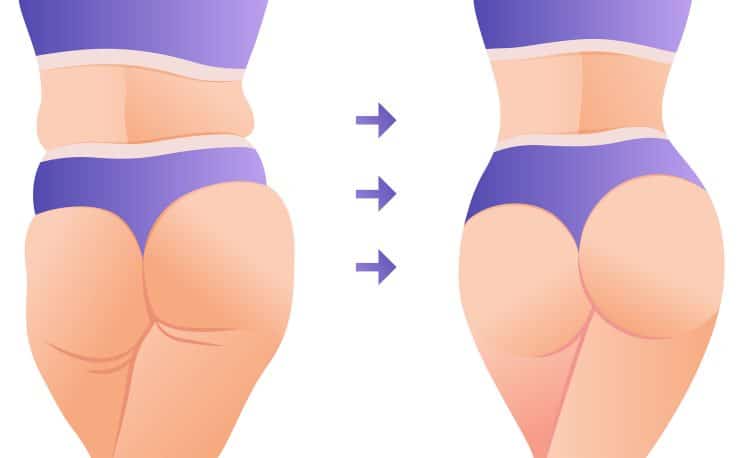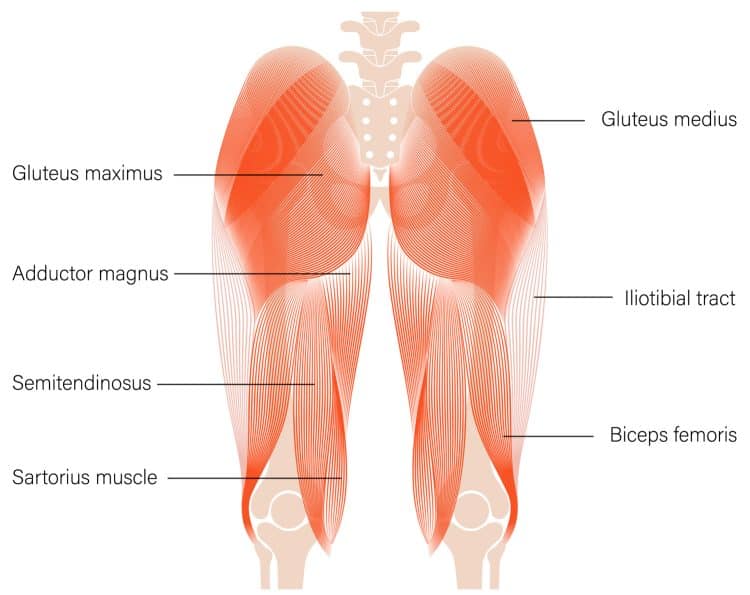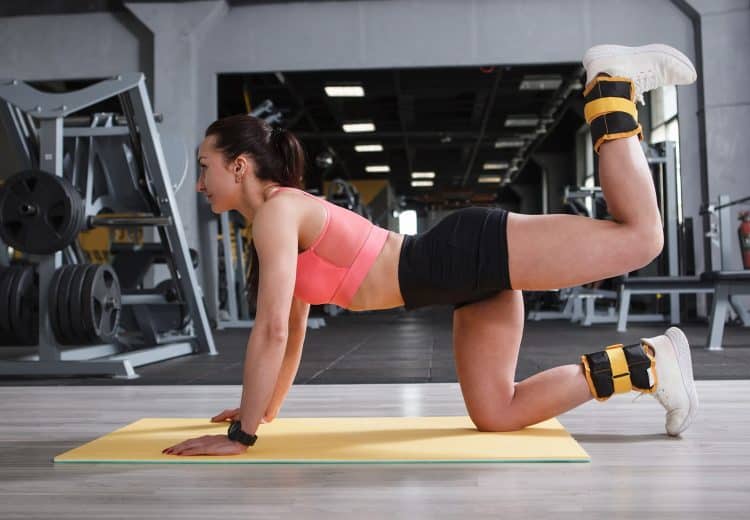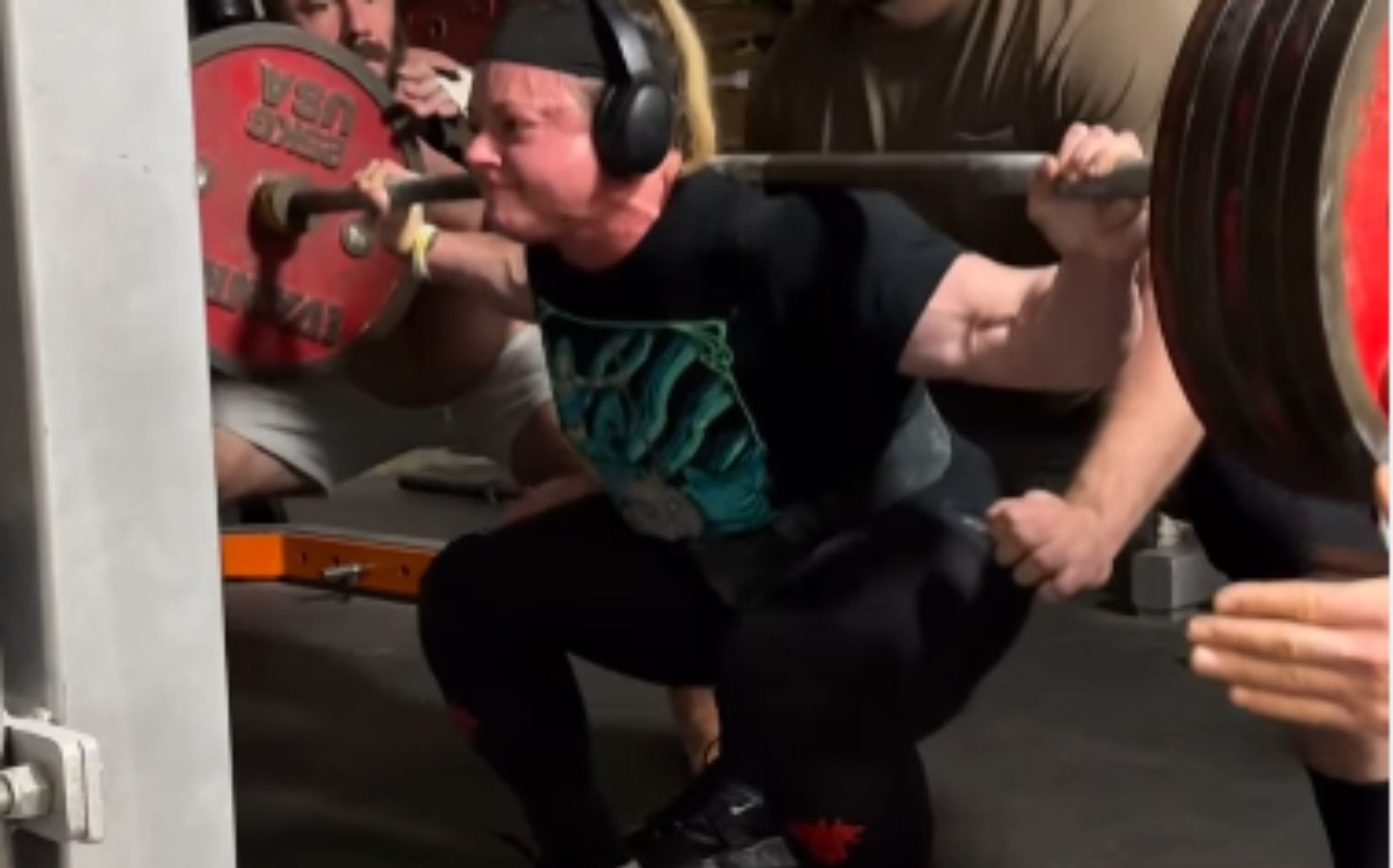Close your eyes, keep a hand on your heart, and be honest to God when you answer this for yourself—which is more attractive, a square butt or a round derrière?
A bubble butt is more than aesthetically appealing. A round butt signifies strong glutes, which can help improve your posture and lower body strength. Plus, it acts as a built-in cushion.
On the other hand, tight hips (like in the case of an inverted or square butt) can be a result of excessive sitting, which can make it difficult for you to stand up straight.
But what makes round butts so attractive?
We are glad you asked.
A round butt adheres to the 1.618 law. No, this is not the amount of carbs you should eat in a day for a slim waist and a big butt. 1.618 represents the golden ratio.
Level Up Your Fitness: Join our 💪 strong community in Fitness Volt Newsletter. Get daily inspiration, expert-backed workouts, nutrition tips, the latest in strength sports, and the support you need to reach your goals. Subscribe for free!
The golden ratio is a mathematical ratio commonly found in nature. When used in a design, it fosters organic and natural-looking compositions that are aesthetically pleasing to the eye.
Plus, researchers found that the sight of a woman’s large butt activates the reward regions of the male brain that are otherwise activated by drugs, alcohol, and food. [1]
So, the next time your eyes are drawn to a curvaceous woman, you can blame mother nature for it. You’re welcome!
If this wasn’t enough, a study found that women with big butts are more intuitive than their smaller butt counterparts. [2]
Different Butt Types
A square butt, also known as a flat butt, is an infamous glute shape, especially in the fitness community. Besides the flat and round butt shapes, there are two more butt shapes that you should know about—the inverted butt and the pear-shaped butt.
Here are the four common butt shapes and their characteristics:
- Square Butt (H-shape): They hold volume up top but flatten out towards the bottom, creating a muffin top.
- Round Butt (O-shape): Represents full hips and fat distribution around the butt cheeks. Kim Kardashian, JLo, and Nicki Minaj fall into this category.
- Heart Butt (A-shaped): Women with a tapered waistline and fat distributed in the lower part of their butt are said to have peach-shaped butt.
- Inverted Butt (V-shape): More fullness at the top but a narrow lower butt.
Although many people use round and heart-shaped butts interchangeably, they are not the same. A round-shaped butt is more aesthetically appealing from the side, whereas a pear-shaped butt looks more curvaceous from the rear.
Factors Affecting Butt Shape
Here are the factors affecting your butt shape:
- Genetics: Your genetics determine the position of your hip bones and pelvis and will dictate your bottom’s shape. Plus, they determine how your body distributes fat.
- Size of your gluteal muscles: Different people have different muscle sizes, origins and insertion points, which can determine the shape and size of your muscles.
- Hormones, weight, and age: Your butt shape often changes with age. For example, the V-shaped but is often associated with elderlies.
- Lifestyle: Your lifestyle, which includes your diet and activity level can affect your butt shape. People with a desk job who eat unhealthily are more prone to a V or H-shaped butt.
Although factors like genetics are unchangeable, you shouldn’t give up hopes of transforming your physique and fixing your square butt. You could develop your glutes by changing your lifestyle and beginning a tried and tested training regimen.
How To Go From a Square Butt to a Bubble Butt
Here is everything you need to know about building a round butt:
1. Start Training
If you want to change your butt shape, you will have to change the shape and size of your gluteal muscles. You get no prize for guessing that exercise is a part of the best non-intrusive way of achieving your bigger butt goal.
The best part is that you don’t need to get a gym membership to build an hourglass figure. Basic bodyweight exercises that you can do at your home can help build the booty of your dreams.
If you could build a Kim K-like butt at home, why doesn’t everyone walk around with a shelf butt, you ask? Laziness, a lack of knowledge, and willpower can be blamed.
2. Fix Your Diet
An effective training program and a nutrient-rich whole-food diet go hand-in-hand in any muscle-building program. Depending on your current body weight, you might need to choose between a calorie deficit or a surplus to achieve your dream figure.
In a calorie deficit, you eat fewer calories than you burn in a day. On the other hand, a surplus includes eating more calories than you expend.
A study concluded that the caloric equivalent of one pound of body weight lost or gained was 3,500 calories. [3]
Furthermore, experts believe you need to eat 500 fewer calories each day, or 3,500 fewer calories a week to lose one pound of fat each week. Similarly, you could gain a pound each week by adding 500 calories to your diet.
3. Don’t Ignore Recovery
It doesn’t matter how hard you train or diet, you won’t see the desired results unless you give your body enough time to rest and recover from your workouts.
You should sleep at least seven to eight hours every night to give your body enough time to recuperate from your workouts. Additionally, you could introduce supplements like protein powders, BCAA, multivitamins, and glucosamine to your diet to streamline your recovery process.
4. Scissors
No, we do not mean the scissors exercise. We mean — a doctor, operation theater, and surgical scissors. You could go under a knife if you want to acquire a bigger derrière overnight.
Some medical procedures to change your butt shape include:
- Brazilian butt lift
- Sculptra filler injection
- Implants
- Emsculpt muscle treatment
- CoolSculpting
However, we don’t recommend this as surgery can never replace the development, symmetry, balance, and aesthetics acquired from working hard on your physique through regular training.
Gluteal Anatomy
Before we get into the best bubble butt-carving exercises, let’s briefly touch upon the gluteal anatomy to understand the structure of our butt so that we can choose the most effective movements to build a round and full butt.
The glutes are a group of three muscles, including:
- Gluteus Maximus: The biggest and strongest muscle in our body. A developed maximus gives our rear a round appearance.
- Gluteus Medius: Controls transverse and frontal plane motion of the femur and hip.
- Gluteus Minimus: The minimus predominantly acts as a hip stabilizer and abductor of the hip.
Exercises to Turn Your Square Butt Into a Bubble Bum
To build a bigger butt, we’ll focus on the gluteus maximus (obviously) and the gluteus medius. The medius is present higher on the glutes and helps improve your muscle separation and aesthetics.
Add the following exercises to your glute training arsenal for a 1.681-compliant butt:
Level Up Your Fitness: Join our 💪 strong community in Fitness Volt Newsletter. Get daily inspiration, expert-backed workouts, nutrition tips, the latest in strength sports, and the support you need to reach your goals. Subscribe for free!
1. Squat
You’re probably not surprised to see the squat on the list. The squat is the ultimate leg builder and a must-do in every booty-building training routine.
How to do it:
- Stand upright with a shoulder-width stance.
- Place your hands behind your head or extend them straight in front of you.
- While keeping your torso upright and keeping your eyes fixed forward, slowly lower your body by bending at your knees and pushing your hips back and down.
- Squat down until your thighs are parallel to the floor.
- Return to the starting position by pushing through your heels explosively.
- Do not lock the knees out at the top.
- Repeat for recommended reps.
Pro tip: You could also perform this exercise using a barbell, resistance band, or dumbbell. Slow down the rep tempo to increase your time under tension to achieve better muscle stimulation.
Check out our detailed squat guide here!
2. Romanian Deadlift
The Romanian deadlift’s limited range of motion allows a lifter to focus on their glutes and hamstrings, whereas the conventional deadlift emphasizes your back.
How to do it:
- Stand upright with a shoulder-width stance.
- Stand behind a barbell so that your legs are almost touching the bar.
- Grab the bar with a mixed or overhand grip.
- Deadlift the weight into position at the top with your hips and knees locked out.
- Lower the barbell towards the floor by pushing your hips back and hinging forward until the bar is just below knee height.
- Return to the starting position explosively.
Pro tip: Tying a resistance band around your knees while performing the exercise will add more tension to your hams and glutes.
Check out our Romanian deadlift guide here!
3. Hip Thrust
The hip thrust is one of the most effective but underutilized glute-building exercises. You’d be leaving gains on the table by not performing this exercise.
How to do it:
- Start in a supine position with your back on a bench.
- Roll a barbell up to your hip crease.
- Drive both feet into the floor and squeeze your glutes while lifting them towards the ceiling.
- Your head to your knees should be in a straight line at the top.
- Pause and contract your glutes.
- Lower your hips back to the starting position.
- Repeat for the desired number of repetitions.
Pro tip: Advanced lifters can use variable resistance in this exercise by tying chains on each end of the barbell.
Check out our barbell hip thrust guide here!
4. Glute Bridge
The glute bridge is a beginner-friendly hip thrust variation.
How to do it:
- Start in a supine position on the floor.
- Place your arms on your sides with your hands on the floor.
- Bend your knees and plant your feet flat on the floor.
- Bridge your hips by squeezing your glutes and driving your heels into the floor.
- Pause and contract at the top.
- Lower your hips to the starting position.
- Repeat for recommended repetitions.
Pro tip: As you get better at this exercise, perform this exercise by placing your heels on a flat bench.
Check out our glute bridge guide here!
5. Lying Hip Abduction
The lying hip abduction is a great exercise to train your gluteus medius.
How to do it:
- Lie down on your side with your legs extended and stacked on top of each other.
- Place your lower arm underneath your head and the top arm on the outside of the top thigh.
- Raise your upper leg as high as possible without using momentum.
- Pause and contract at the top.
- Slowly lower your leg to its starting position.
- Repeat for recommended reps before switching sides.
Pro tip: Wrap a resistance band just below your knees to add resistance to the exercise. You could also place a weight plate on top of your top knee to make this exercise harder.
Check out our lying hip abduction guide here!
6. Donkey Kickback
The donkey kickback should be your go-to exercise if you want a shelf butt and a pronounced separation between your hamstring and butt.
How to do it:
- Get on all fours, with your hands stacked directly under your shoulders and knees under your hips.
- Make sure your back is flat at the starting position.
- Keeping the 90-degree bend in your right knee, slowly lift your leg straight back and up toward the ceiling as high as possible.
- Pause and contract at the top.
- Return to the starting position.
- Repeat for recommended reps before switching sides.
Pro tip: As you gain more exercise, perform this exercise on a Smith machine or a leg extension machine.
Check out our donkey kickback guide here!
7. Clamshell
The clamshell is another potent exercise to target the gluteus medius. It is one of those exercises that looks super easy but will annihilate the target muscles.
How to do it:
- Lie on your side, with your legs stacked and knees bent at a 45-degree angle.
- Rest your head on your lower arm, and place your top hand on your side.
- Keeping your feet touching, raise your upper knee as high as possible without shifting your hips or pelvis.
- Ensure your lower leg is planted on the floor throughout the exercise.
- Pause, and contract your glutes at the top.
- Return your upper leg to the starting position.
- Repeat for recommended reps before switching sides.
Pro tip: Use a resistance band or place a weight plate on your top knee to add resistance to this exercise.
8. Walking Lunge
The walking lunge is one of the most underrated bubble butt-building exercises.
How to do it:
- Stand upright with your feet shoulder-width apart and a dumbbell in each hand.
- Step forward with one leg and allow both knees to bend simultaneously.
- Descend until the back knee is a few inches off the floor.
- Drive through the front foot and extend the knee as you stand up fully and return to the starting position.
- Repeat on the opposite leg.
- Alternate between legs for recommended repetitions.
Pro tip: Pause at the bottom of the rep for better glute recruitment. Make sure you’re not bending forward while performing the exercise.
Check out our lunge guide here!
9. Fire Hydrant
The fire hydrant is a great exercise to place constant tension on your glutes.
How to do it:
- Start on all fours. Place your shoulders above your hands and your hips above your knees.
- Brace your core and look down.
- Lift your left leg away from your body at a 45-degree angle while keeping your knee at 90 degrees.
- Lower your leg to starting position.
- Repeat for recommended reps before switching sides.
Pro tip: Pause at the top of the movement for as long as possible for a glute-popping muscle pump.
Check out our fire hydrant guide here!
10. Cable Glute Kickback
You should begin your glute training workout with this exercise if you have trouble establishing a mind-muscle connection with your butt.
How to do it:
- Set a cable pulley at the lowest setting and attach an ankle cuff attachment.
- Choose an appropriate weight on the selectorized machine and wrap the cuff around your left ankle while facing the machine.
- Take a step back from the machine, bend forward, and grab the pulley for support.
- Slightly bend your left knee and raise it off the floor by a few inches.
- Raise your heel towards the ceiling by hinging at your hips without bending your knee.
- Pause and contract at the top.
- Slowly return to the starting position.
- Repeat for recommended reps before switching sides.
Pro tip: For better glute isolation, perform this exercise with your hands and non-working knee placed on a flat bench.
11. Machine Hip Abduction
Machine hip abduction is one of the most popular and effective gluteus medius exercises.
How to do it:
- Place your back against the pad and your spine neutral.
- Adjust the pads so they are outside your knees.
- Exhale and push your legs as far apart as possible.
- Pause and contract at the top.
- Slowly return to the starting position.
- Repeat for recommended reps.
Pro tip: To better isolate your abductors, lift your hips a few inches off the seat while performing this exercise. Grab onto the weight stack pillars for balance.
12. Lateral Band Walk
The lateral band walk is an incredibly effective exercise to work the gluteus medius.
How to do it:
- Stand upright with a shoulder-width stance.
- Wrap a resistance band around your legs just above your knees.
- Get into an athletic position by bending your knees and pushing back your hips slightly.
- Take a step to your side.
- Repeat for 5-10 steps in the same direction before switching sides and returning to the starting position.
- Begin the second set in the opposite direction.
Pro tip: Make the exercise harder by taking sumo side steps.
Wrapping Up
It’s no secret that bubble butts are in and here to stay. Add the exercises mentioned in this article to your training regimen to turn your pancake ass into a peach.
Remember, you need to master the trifecta (training, diet, and nutrition) to achieve your desired results. We hope to see your transformation photos on Instagram. Don’t forget to mention us @fitnessvoltnetwork. Best of luck!
References
- Platek SM, Singh D (2010) Optimal Waist-to-Hip Ratios in Women Activate Neural Reward Centers in Men. PLOS ONE 5(2): e9042. https://doi.org/10.1371/journal.pone.0009042
- Bremser JA, Gallup GG Jr. Mental state attribution and body configuration in women. Front Evol Neurosci. 2012 Jan 30;4:1. doi: 10.3389/fnevo.2012.00001. PMID: 22319496; PMCID: PMC3268185.
- WISHNOFSKY M. Caloric equivalents of gained or lost weight. Am J Clin Nutr. 1958 Sep-Oct;6(5):542-6. doi: 10.1093/ajcn/6.5.542. PMID: 13594881.

